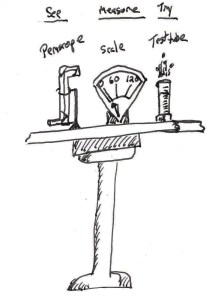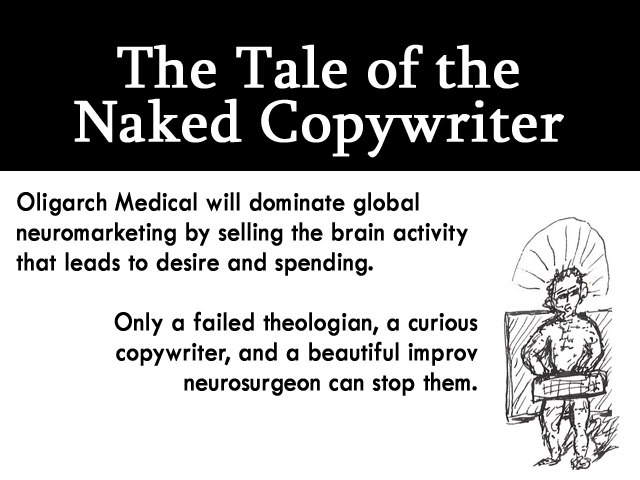Archive for the ‘Audience’ Category
Business Writing Can Be Better
Let’s Worm Backwards to Walk Forward
Our goal is to say or write our idea more clearly.
Along the way we’ve picked up this notion that there might be more to communication than us just delivering thin slices of thought from head to mouth (or pen/keyboard)to our boss’s brainpan. We’re starting to think the process of communication does a bit of turbocharging to the idea and to the people on either end of the idea.

Take It From a Copywriter
That turbocharging is exactly what James Webb Young counted on. Young was an advertising copywriter who lived and wrote in the last century. His goal was to express ideas for money—he marketed products. So old ideas, cliched ideas, worn-out words and weary images—none of that would do. All that dated content was the same as saying, “Let your eyeballs slide past—you’ve seen this before and it doesn’t matter.”
Young held a particular fascination for two phases of pre-writing: preparation and organizing. His love of revision may not have been far behind. He thought new ideas were just recombinations of old ideas, so he did his best to fill his brain with all he could find out about a new product or new project or new assignment. Part of the copywriter’s role in the world is to ask the most elementary questions, because forcing experts to simplify can reveal profound truths. He wanted to know everything, much like British copywriter Tony Brignull.
Asking questions, getting information, and then stripping ideas and combining and recombining ideas and then joining ideas that are impossible to join and then splitting ideas that are fused—all this until exhaustion sets in. And then the walk-away and then, if all goes well, the “Eureka!” Read more in Young’s book A Technique for Producing Ideas.
Why Business Writing Sucks
It’s because writing is not our job. We’re engineers. Or scientists. Or physicians. Or managers. Our job is that noun or verb in our title, not writing. We’re doers, dammit! But we’re also humans, and humans learn by telling and by listening. It’s our time-honored way of becoming less stupid.
But because our work-time is focused on the important stuff of our job, we miss the important stuff of being human together. So we pick words and images from the last decade to express our new idea and then slap them on paper or PowerPoint as quickly as possible to stop the pain of writing. And then we wonder why no one cares and why the boss with the budget won’t listen.
Good communication means digging deep into why something matters. Often that involves self-revelation which also might call forth emotion. These are things humans use to communicate.
Worm Your Way Back into Your Process
To communicate in powerful ways, we must prepare ourselves and our message.
If we expect it to just happen, if we expect to throw-together some presentation, we doom ourselves to ready-made clichés and images, which are guaranteed to be ignored.
Powerful communication means going back to gather information, to ask what we want to accomplish, to think about our audience, to combine old ideas to get new ideas, to worry these ideas on paper until a fresh, revealing communication portal opens.
Along the way, expect a turbocharge that changes the idea, that changes the thinker (you), and might possibly change your relationship with the person at the other end of the conversation.
###
Image credit: Kirk Livingston
Persuade Me
But Not With Your Dumpster Words
Academic journals are near the top of our list for credible sources of information. The work of Retraction Watch (along with Professor Carl Elliot’s snarky Fear and Loathing in Bioethics) has helped me understand that peer-review processes are fallible and can be gamed. Still, the intent of providing transparent work that smart people can discuss seems a solid route to truly reliable knowledge.

Promotional copy is on the other end of the continuum. As a copywriter, I try to use reason and logic to engage readers. And I’ll bring in emotion to tell my client’s story. But I want a discussion, not a manipulative parlor trick. Good copy addresses humans with reason, logic, and emotion that honors our humanness without resorting to manipulation. After all, that’s how humans talk with other humans.
A Continuum of Believability
Further down the continuum of believability is sales talk. It’s the kind of stuff we hear from the used car salesman and telemarketers or our 45th president: “best,” “tremendous,” “today only,” “you’ve never seen anything like this.” These are dumpster words that signify active lying or passive disinformation. You can tell by the lack of specificity. The words are in-credible, that is, not believable and we should turn away from them.

Somewhere in the middle of the continuum of believability are persuasive commentaries and editorials that are biased and meant to convince. Their authors acknowledge their bias straight on and early in their communication. We see their bias and take that into account as we read. Even nearer the middle of the credibility continuum is instructional words that aim to help the reader accomplish something. That’s what my current class is about—helping readers take some action out in the world.
If we are aiming toward credibility in our communication (a typical goal for sane people), we’ll pull from the tools and building-block thoughts that are well-vetted with facts and citations from other credible sources. We’ll also grab from the piles of words that invite further reflection and discussion. The more credible we want to be, the more we’ll direct our typing hands away from the sales talk words, those dead-end, short-circuiting, dumpster words that deceive and misdirect as they are spoken or written.
Smart People Discuss for Credibility
It’s how we sort most everything in life. By talking together about a book or a movie or a social problem or a new idea, we can often get to credible and truthful statements. Statements that we can believe and act on. But to get to that place of belief, we need to think critically about the pop-up slogans and pre-conceived notions that our ideology or brand-preference have placed in our brainpans. If we resist those clichés and talking points and instead look for words from our own experience, no matter how messy or awkward, we have a chance of getting to the truth.
Credible information withstands questions and discussion by smart people. Credibility is a way forward.
I am eager for our culture to develop a taste for credibility.
###
Image credits: Kirk Livingston
3 Ways to Strengthen Your Next Think-Piece
Leadership is an emotional action story
Most of my clients see themselves as thought-leaders. These clients really are leaders in their industries: their scientists and engineers labor to create new ways of approaching old markets even as they open new markets. A think-piece is an outward-facing story of their leadership in the light of a market problem or need.
Some clients assume their brochures and web copy can be repurposed into a think-piece. One of my tasks is to help them understand that a think-piece takes a position on a problem, spins out a story that shows the problem resolved in an emotionally satisfying way. That is typically a larger frame of reference than their current brochure or web copy.
Other clients want to say something without revealing anything. They worry about competition in their tight market. But they don’t realize how a generous spirit is another kind of selling (especially in this sharing economy), and giving something-not-everything away is a mark of true leadership. But it’s just too big a task (they say) and it will “only distract our scientists and engineers.”
Sharp clients understand that thought-leadership presents a story that is immediately recognizable, universally understood (by their target audience) and easy to digest. They also understand that the best stories carry a useful thought with an emotional element.
My favorite thought-pieces typically have these three elements:
- Story: A story is threaded together with real people doing real things. There is emotion in a story—just like life—and real people talk in human rather than PR speak. Real people with real problems that unlock real emotion both before and after the solution appears.
- Visual: There’s no question that words simply take too long for most of us. We still read, of course, but our short attention spans move us toward images and video. Some say visual is the primary way social media will present in coming years. We can put that visual bias to work today with words that paint pictures. That has always been the novelist’s forte: creating scenes. That ability must find a home in today’s think-pieces. Gone are the days when an interested audience member might happily read your brochure. Now you have to catch them when they are not looking or thinking about your product or industry. This is not an easy task, but the more visual the better. Visual also has the advantage of being immediately understood.
- Speak Human: Every discipline has its own secret words. Every industry uses lingo and code words to show they know their stuff as well as out of sheer laziness. It’s just easier to say the same things as everyone else. Plus it’s a badge of the tribe, so why wouldn’t you? But insider language is inherently toxic for anyone outside. It’s a buzz kill for an outsider looking in. Speaking human means words cleansed of jargon, words that can shine through a clear story.
The best think-pieces don’t appear to be think-pieces at all. They can be read so effortlessly that we take every step with the author to the intended conclusion. And we find ourselves happy to be there, taking action with the hero.
###
Image credit: Kirk Livingston
How to be an Object of Pity
Hint: Grow a gray beard and present folding-money
Twice now young women have bought me coffee at the coffee shop on the campus where I teach. Just standing in line like everyone else—minding my own business—I pull out my $2 (cash-money) and the young woman in line behind me says, “Just put it on my card.”
I resist: “No! I wouldn’t hear of it,” I say. “You can’t. You must look after yourself with that—or at least spend it on your friends.”
I went on in that vein, until the cashier reached past my $2 (cash-money) for the woman’s card.
“She’s not going to spend it all anyway,” said the cashier, repeating what the woman said.
So. Free coffee. Thanks profusely offered.
Yesterday: same thing. I pull out my $2 (cash-money) and the young woman behind me says, “Just put it on my card.”
I resisted. This time with less velocity. Free coffee. Thanks profusely offered.
 I’ve puzzled over this phenomenon. What I know for certain is that the students here are some of the kindest people you’d ever hope to meet. And earnest. Looking around I also see that I have landed from the planet “old guy.” Though I know even recent grads feel that way when revisiting their alma mater. Still, it’s been a long time since I was an undergrad.
I’ve puzzled over this phenomenon. What I know for certain is that the students here are some of the kindest people you’d ever hope to meet. And earnest. Looking around I also see that I have landed from the planet “old guy.” Though I know even recent grads feel that way when revisiting their alma mater. Still, it’s been a long time since I was an undergrad.
But I think it’s the folding money that triggers the pity. What kind of a person uses cash-money on campus? Clearly someone in need and, frankly a bit out-of-touch. We all use cards.
You must not be from around here.
“Let me help you.”
The other day a student reflected on her community-building work in our social media marketing class:
“It’s also important to create a presence that encourages interaction,” she said.
I can’t get her comment out of my mind, partly because of getting two free coffees and partly because of the riddle of how to write in a slightly-unfinished, slightly-needy way.  Like how Columbo conducted investigations: you pity the unkempt, needy fellow until you realize he is canny like a fox.
Like how Columbo conducted investigations: you pity the unkempt, needy fellow until you realize he is canny like a fox.
I’ve long puzzled over the magnetism of a dumb sketch. Stepping up to the white board and drawing something badly as a way of explaining an idea is a sure-fire way to invite others in. And they step up—not to correct, just to collaborate. Because it’s sorta fun to draw badly and without the pressure to create art. And it can be fun to think together. And, like presenting folding-money in debit card economy, you clearly need help.
Because it’s sorta fun to draw badly and without the pressure to create art. And it can be fun to think together. And, like presenting folding-money in debit card economy, you clearly need help.
What are you willing to leave unfinished to draw others in?
###
Image credit: Kirk Livingston, The-Toast.Net
4 Ways to Bring Creativity to Work
Hint: Creativity is not easily contained
I’ve been reworking priorities for the social media marketing and copywriting classes I start teach again in January. If these are like previous classes (I’ve not yet looked at the rosters), there will be quite a few English majors, juniors and seniors, many of which will be excellent writers. I teach the class in a sort of writing-forward way: we use writing as our primary tool for sorting client brand problems and opportunities. But over the last few years, the copywriting class has morphed from a focus on “copywriter” to “idea writer,” which is a book by Teressa Iezzi that I’ve become very attached to. We use The Idea Writers as a text to help grow our understanding of our task.
My syllabus is mostly intact from last time I taught, but this time it I see four areas where additional emphases are needed. These four areas make it difficult for a student to jump from writing papers for an English professor to writing copy in the world of commerce:
- See: this has to do with trying to get out of your own brain-pan and jumping into someone else’s life situation. Read more: How to Go Out of Your Mind
- Try: social media, in particular, rewards those who jump in and try stuff—all sorts of stuff. Trying stuff is a way of learning what your audience will listen to, and will respond to, along with understanding the limits of their attention. Yes there are some best practices and some favored tools, but social media is in constant motion.
- Measure: The goal really is to move the needle, that is, to get a response. Hits, page views—so many of these numbers are really only incidental to engagement. Real engagement looks like a comment or a share or some other solid action in the world. This is debatable, of course, and varies by audience and objective. But social media opens a window to see just what effect our words and ideas can have. Which can also be terribly discouraging for a writer with a message to deliver.
- Passion: This is the surprise for students, that they can channel a passion about a topic or tool or process into a project for a client. Many think passion and inspiration are ingredients only safely stirred into their own poetry or short stories. It turns out the more you run on inspiration, the more you run with inspiration.

“Inspiration” by Richard Bledsoe
Richard Bledsoe’s interpretation of “Inspiration” is completely right: there is often a point where the idea carries the writer forward, eyes bulging, wishing only to stop.
###
Dumb Sketch: Kirk Livingston
Image credit: “Inspiration” by Richard Bledsoe, used with permission
From “You Suck” to “Say More”
Advance Your Conversations by Providing Wee Bits of Pivot

My client has a big agenda for her healthcare organization: she wants her colleagues to reconsider how they purchase their millions of dollars of medical equipment every year. As we talked we realized there are a set of steps her colleagues take to see things differently. Every conversation can be a step, bringing in information, yes, but more importantly, bringing in emotional connection, along with wee bits of pivot. She needed to provide the right information at the right time at the proper emotional setting.
That’s because we use rational thought to change our minds. But changing our minds is also an emotional activity. Reason and emotion together help us see and do things differently.
If you are convinced you are right about something—and most of us are dogmatic by default on dozens of topics—then you state your opinion flat out and your conversation partner is forced into a binary response:
- “Yes—I agree. You and I, we are brothers.” or,
- “No. You suck and now I hate you forever.”
But if we dial dogmatic back a notch and consider that another opinion may help us, we are poised to deliver words with wiggle, words that help us move forward in a conversation. What we say next allows us to bring more information along with our own emotional force. And even if we don’t persuade someone of our opinion, we’ve had a conversation where we’ve learned something.
And that is significant.
We need a lot of wee bits of pivot just now. Conversations about race, about policing, about religion, about politics—all of these are ripe areas for letting go of the dogmatism that leads to binary thinking.
Can’t we all just have better conversations?
###
Image credit: Kirk Livingston
If you say a dumb sketch, will others pay attention?
Engineers aren’t the only ones who love to correct you
I’ve been repeating myself recently to different people and groups within my client’s shop.
I’ve been saying aloud the oral version of a dumb sketch. I’ve been telling and retelling the story of how I thought one thing but then in conversation with different experts, came to see what I thought was really not so at all, but something different. I know this is terribly abstract and I apologize: We’re working on a new proprietary idea at the moment, so I cannot be too specific.
I thought X was like Y. But it turns out that X is very like Z. And when I tell that story—of trying and failing and trying—my listeners get it. They learn something. They jump to Z and each gets pretty excited about Z—they had not seen Z before. But now that Z is named and out there, Z may just change everything (and not in a breathless marketing-hype way, but really change how people move forward in this particular industry) (Which I cannot name.) (Sorry.) Each mini-audience put the pieces together and then leaps forward in a way my didactic, linear, word-driven paragraphs did not succeed at.
 The point of a dumb sketch is to be not-finished. A sketch is the opposite of the heavily produced diagram or slide. The “unfinishedness” of a sketch is the very crux of usefulness as a communication tool. By being unfinished, the sketch invites collaboration and improvement. And people seem to not be able to turn away—at least from the oral version. Failure is built right into my story, and who can resist gawking at a car wreck?
The point of a dumb sketch is to be not-finished. A sketch is the opposite of the heavily produced diagram or slide. The “unfinishedness” of a sketch is the very crux of usefulness as a communication tool. By being unfinished, the sketch invites collaboration and improvement. And people seem to not be able to turn away—at least from the oral version. Failure is built right into my story, and who can resist gawking at a car wreck?
Maybe this is an engine behind John Stepper’s notion of “working out loud.” Maybe this is a key to how we collaborate with each other. We already do this with friends and family, but what if we extend our try-fail-try circle to include many others?
###
Dumb sketches: Kirk Livingston



